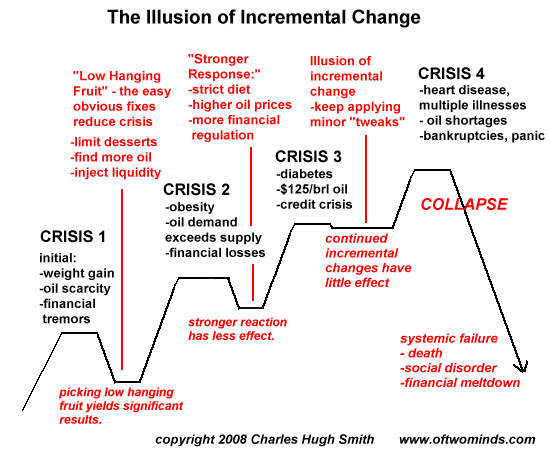The High Water Mark of a Broken System: U.S. "Healthcare"
Courtesy of Charles Hugh Smith, Of Two Minds
The U.S. "healthcare" system is broken financially and in terms of improving the overall health of the citizenry; costs have doubled, with no end in sight.
Whether the massive 2,700-page "reform bill" passes or not, this is the high water mark of America’s broken "healthcare" system. I call U.S. "healthcare" sickcare because it is failing to improve the health of the citizenry even as its share of GDP has doubled in the past 30 years.
This is the high water mark because the fiscal insolvency built into the system will only gain momentum from this point in time.
Here are the core facts:
1. The U.S. spent 17.6% of its GDP on "healthcare" in 2009, while other developed economies (Japan, Britain, Spain, Italy, Australia, et al.) spent roughly half that share (about 8.5%).
2. Thirty years ago, the U.S. also spent about 8.5% of its GDP on healthcare.
3. Even though we spend twice as much as other developed countries, the health of our workforce lags the health of workforces in nations which spend half of what we do.
4. The health of our workforce is only marginally better than the workforces in countries which spend 15 cents for every dollar we spend on healthcare.
I have covered the fundamental problems of the U.S. sickcare system recently in three articles for AOL-Daily Finance. The above data is sourced in the first story:
Skyrocketing Health Care Costs Hamper U.S. Competitiveness
Improving Americans’ Health, With or Without Health Care Reform
Is Fee-for-Service What Ails America’s Health Care System?
Three key concepts of the Survival+ analysis illuminate the inherent insolvency and failure of U.S. sickcare:
1. An integrated understanding of health and well-being reveals that the American way of growing food/raising animals/selling packaged food, its diet and its approach to fitness are fundamental drivers of diseases which cannot be "fixed" with surgery or pills–the two "hammers" sickcare deploys against all diseases.
An integrated understanding of food, health, diet, fitness, community, autonomy, transparency and responsibility are the building blocks of a positive approach to healthcare/public health.
I am indebted to Dr. David D. (M.D.) for an introduction to Ivan Illich’s profound critique of healthcare, Limits to Medicine: Medical Nemesis, the Expropriation of Health and his other work, including Disabling Professions.
(I also want to acknowledge the other readers who introduced me to other concepts in Illich’s vast body of work, which also includes Toward a History of Needs andDeschooling Society.)
Any system without patient autonomy and responsibility, and full transparency in cost, price, profit, history of results, etc. is inherently doomed to fail on multiple levels.
2. Insurmountable Barriers to Structural Reform explains how sickcare’s protected fiefdoms and fortesses of complexity doom any structural reform efforts to failure.
3. The illusion of incremental change offers the false promise that 2,700 pages of tweaks and trims can "reform" a system which is ontologically (inherently) flawed to its very core.

It seems obvious to me that whether this "illusion of incremental change" legislation passes or not, sickcare is already crumbling at the edges as the costs rise and ever more marginal returns are the result.
The sickcare system is already doomed to insolvency and collapse, and the only question is how long the insolvency can be hidden by borrowing trillions of dollars from somewhere. I would guess that sickcare will seriously start devolving within five years (2015)– again, whether this "landmark legislation" passes or not.
This legislation addresses none of the system’s core flaws, and leaving it "as is" will also do nothing to change the coming implosion. All the protected fiefdoms, from Big Agriculture to the packaged food giants to the fast-food multinationals to insurers, hospitals, attorneys, pharmaceutical companies, service unions, Medicare, Medicaid, "professional groups," lobbyists, the FDA and other agencies, etc. etc. etc. will cling to the present model until it implodes, practicing internecine warfare between protected fiefdoms to maintain their share of the swag.
The people actually trying to function in the system–the doctors and nurses–know it is broken, but they are essentially powerless to make any structural changes.
And so devolution will lead to insolvency, and in the painful aftermath, a system built on an integrated understanding of food, diet, nutrition, community, fitness and health and patient autonomy/responsibility can be slowly assembled from the bottom up, by providers and the patients who choose them.



